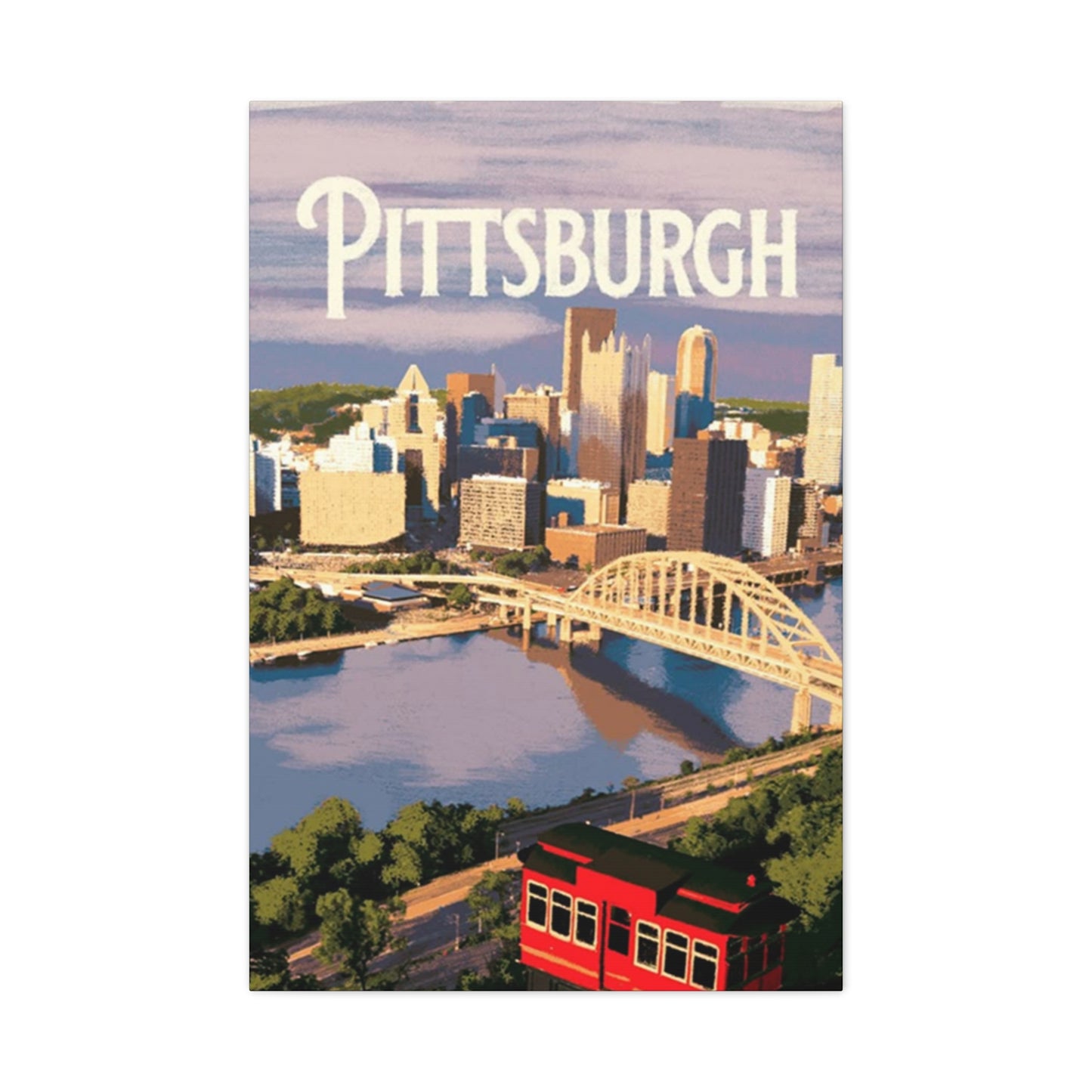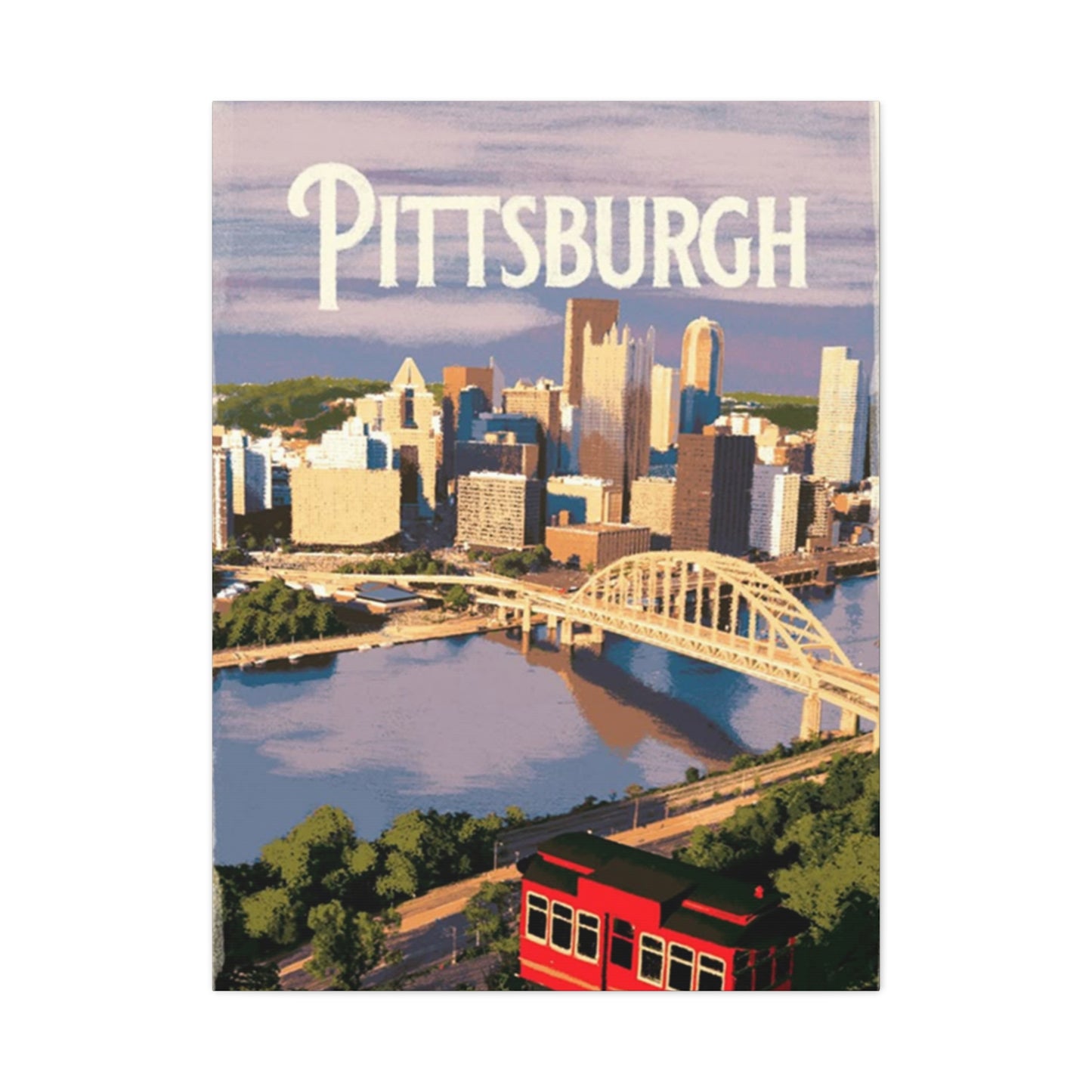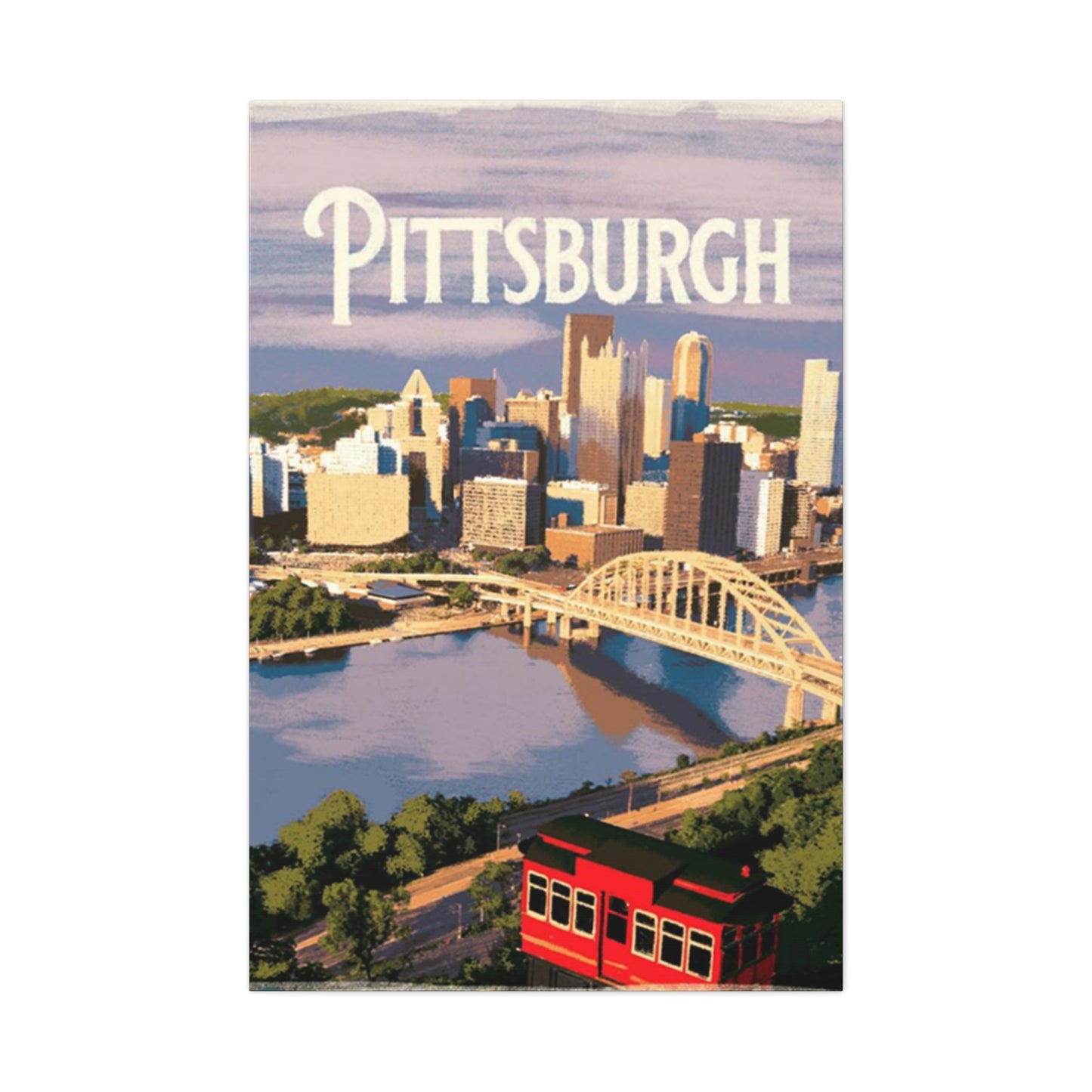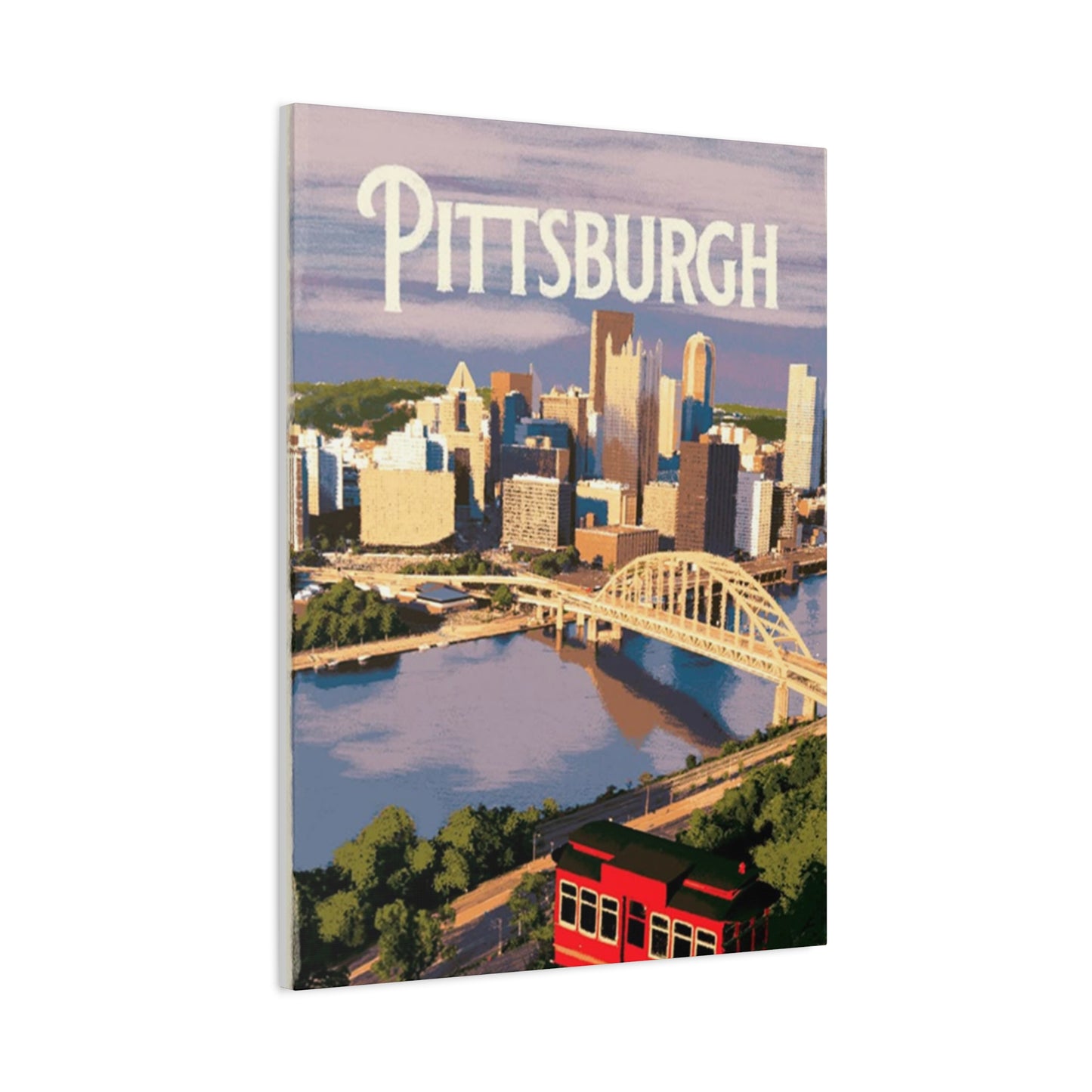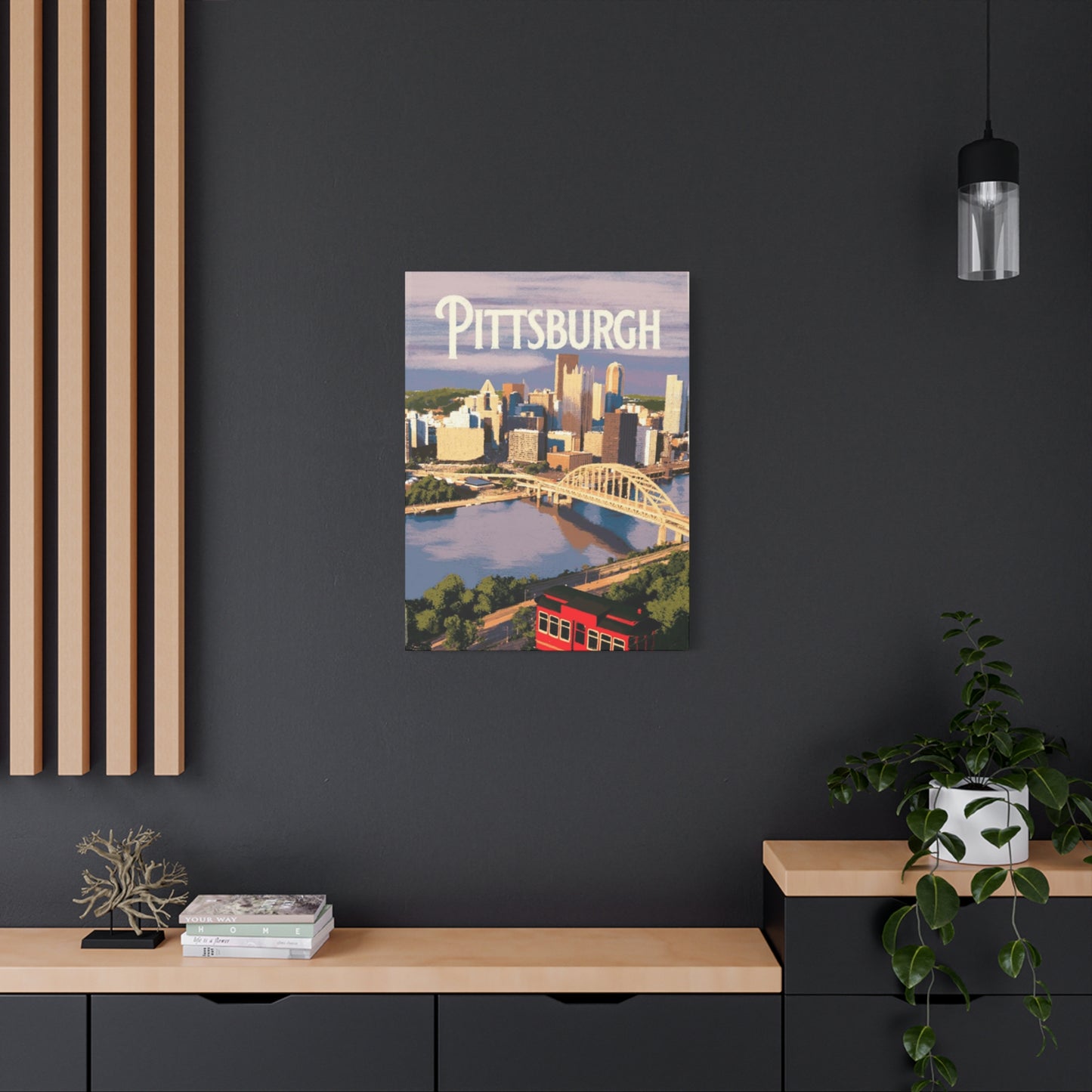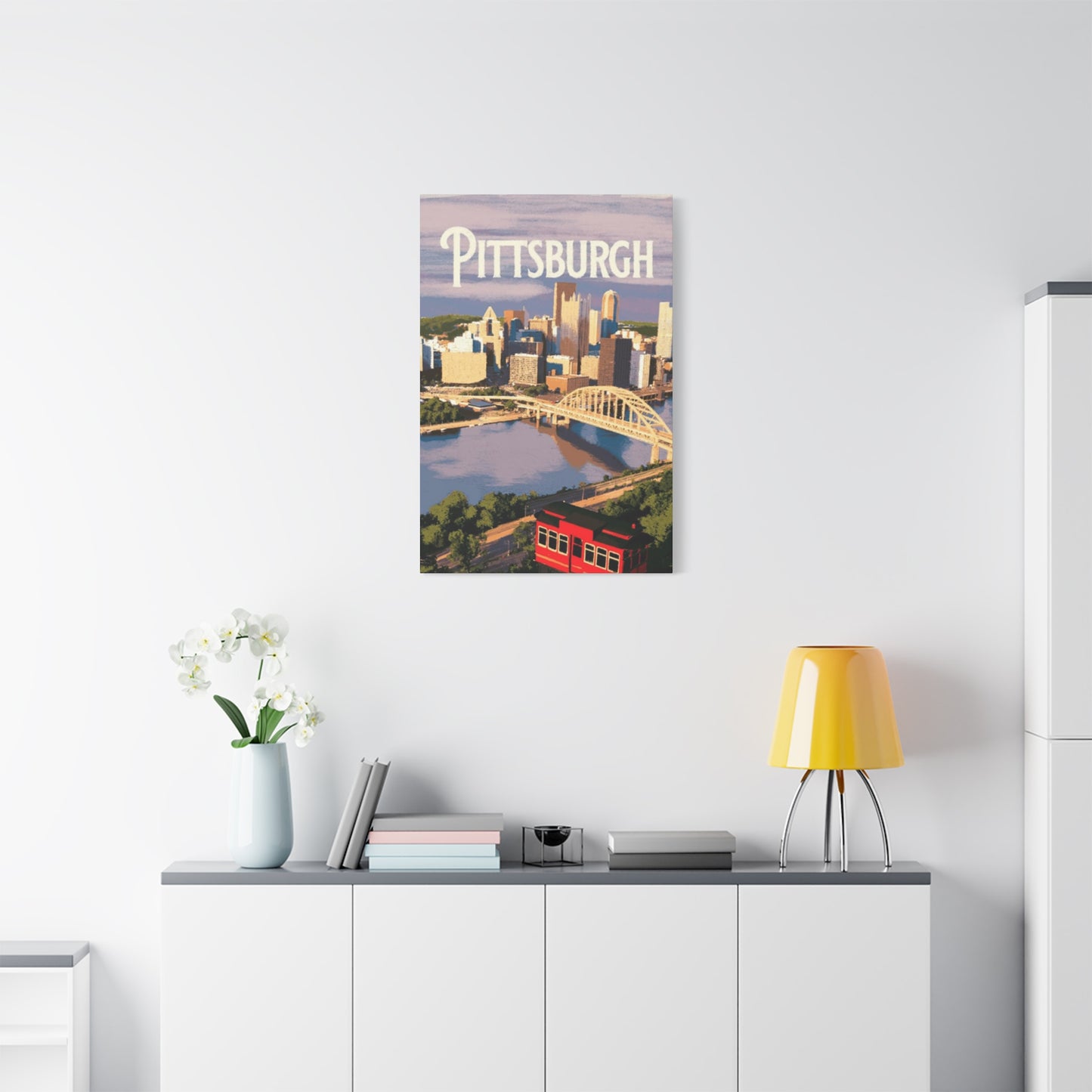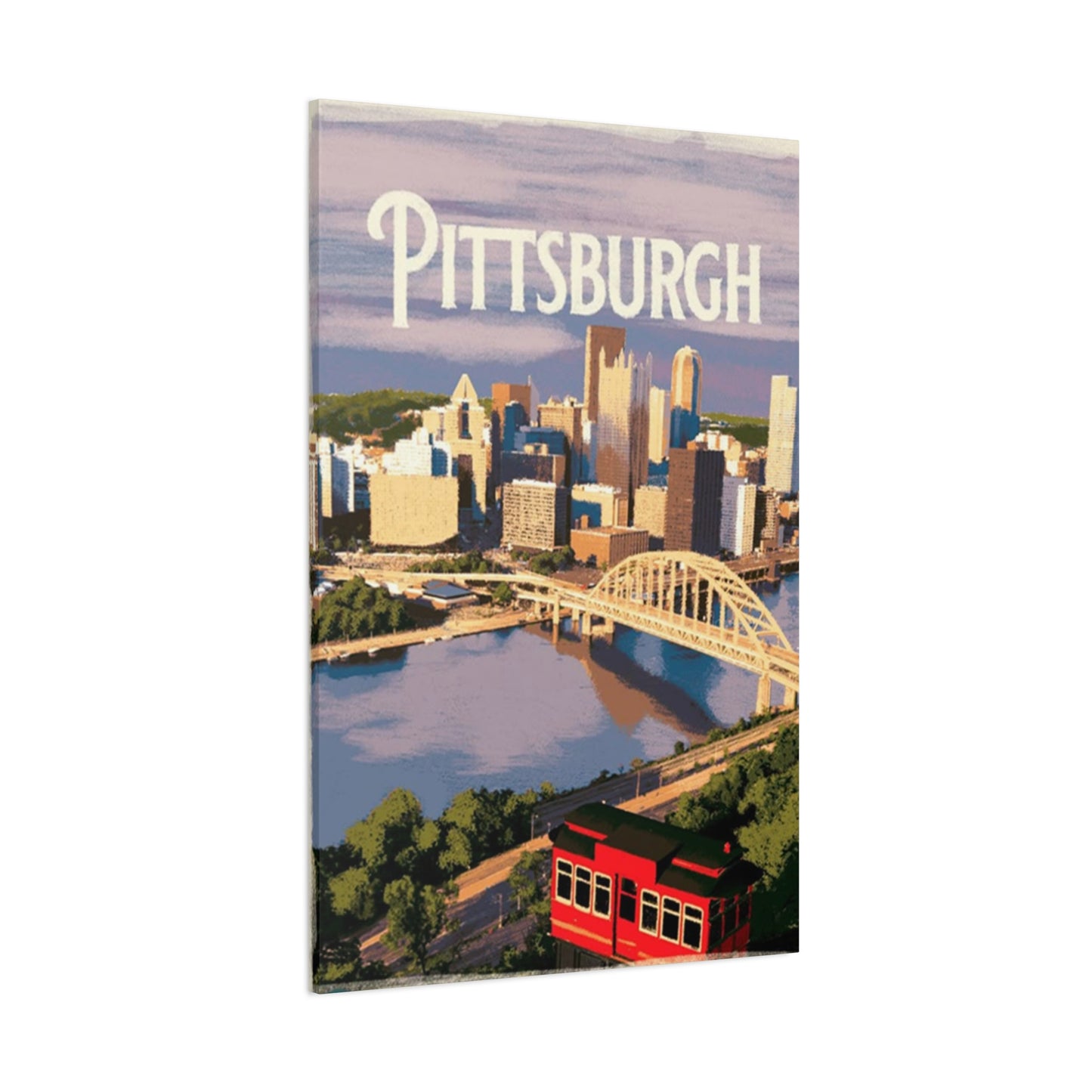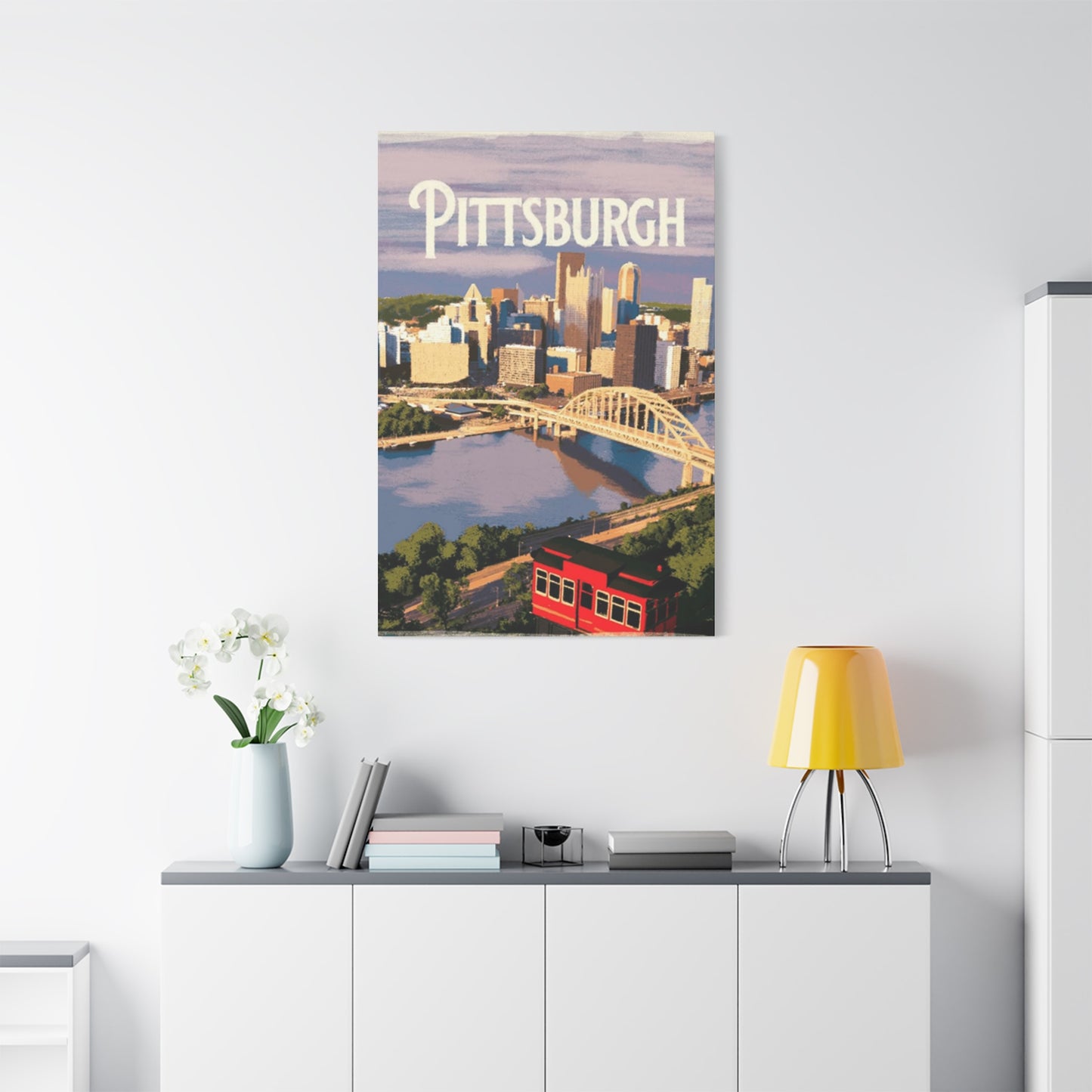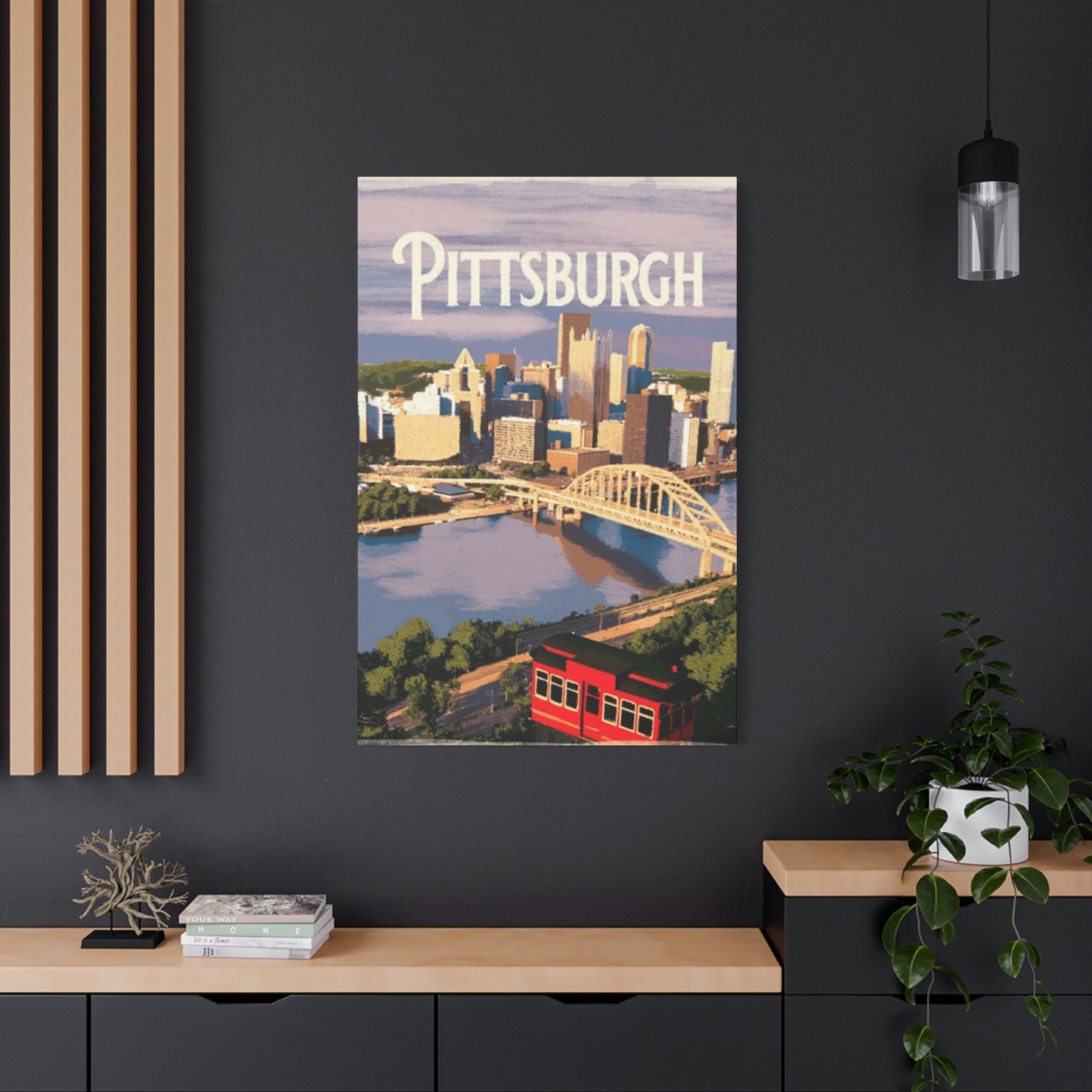Pittsburgh Bridge River Poster Wall art: A Stunning Wall Art for Urban Aesthetics
Pittsburgh stands as one of America’s most visually captivating cities, a unique urban landscape where the interplay of architectural marvels and natural waterways creates endless inspiration for artistic expression. Known as the “City of Bridges,” Pittsburgh boasts over 446 bridges, more than any other city in the world, gracefully arching over the confluence of three rivers—the Allegheny, Monongahela, and Ohio. This remarkable engineering feat, combined with the city’s vibrant skyline and lush riverbanks, offers a timeless scene that captivates both residents and visitors alike.
Artistic representations of Pittsburgh’s bridges and rivers have become a popular choice for contemporary interior design, serving not only as decorative elements but also as meaningful tributes to the city’s unique heritage. A Pittsburgh Bridge River Poster transforms any living space into an urban sanctuary, evoking a sense of place and pride. Whether displayed in a modern loft, a cozy apartment, or a corporate office, this type of wall art adds depth and character, connecting viewers to the city’s dynamic history and its ongoing story of innovation.
The appeal of Pittsburgh Bridge River Poster Wall Art lies in its ability to capture the juxtaposition of industrial grit and natural beauty. The steel frameworks of the bridges, often silhouetted against dramatic skies or mirrored in the shimmering rivers below, convey strength and resilience. Meanwhile, the flowing waterways and surrounding green spaces introduce an element of tranquility, softening the hard edges of urban infrastructure. This balance makes such artwork incredibly versatile, complementing a wide range of interior styles—from minimalist to eclectic, industrial to contemporary.
Moreover, Pittsburgh’s cityscape offers an ever-changing palette for artists. The warm glow of a sunset reflecting off the bridges, the crisp clarity of a winter morning blanketed in snow, or the vibrant energy of night illuminated by city lights—all provide rich visual narratives that enhance the emotional impact of wall art. The vivid colors, dynamic compositions, and meticulous details found in these posters invite viewers to not only appreciate the aesthetics but also to reflect on Pittsburgh’s cultural and historical significance.
Incorporating Pittsburgh Bridge River Poster Wall Art into interior design is more than a stylistic choice—it’s a way to celebrate urban identity and communal memory. For Pittsburgh natives, it’s a nostalgic homage to home; for admirers of urban architecture and landscape photography, it’s a source of inspiration and admiration. This type of artwork can spark conversations, evoke memories, and inspire exploration, making it a focal point in any room.
Furthermore, the growing trend of urban-themed décor underscores the increasing appreciation for cityscapes as art forms. Cities like Pittsburgh, with their unique blend of industrial heritage and natural landscapes, challenge traditional notions of beauty and invite fresh perspectives. By displaying a Pittsburgh Bridge River Poster, individuals embrace a modern aesthetic that honors craftsmanship, history, and the symbiotic relationship between nature and human ingenuity.
Capturing Steel City Infrastructure Through Visual Art
The transformation of Pittsburgh's most recognizable structures into decorative pieces represents more than simple reproduction of cityscapes. These artistic interpretations capture the essence of a community that rebuilt itself through innovation and determination. When selecting pieces that showcase the city's famous crossings over its three rivers, collectors invest in more than decoration; they acquire visual narratives that speak to human achievement and urban evolution.
Artists working in this genre employ various techniques to represent the distinctive yellow-painted structures that have become synonymous with the city's identity. Some favor photorealistic approaches that highlight every structural detail and rivet, while others embrace impressionistic methods that emphasize mood and atmosphere over precision. The choice between these artistic philosophies depends largely on the aesthetic environment where the piece will ultimately reside.
Contemporary interpretations often feature dramatic perspectives that showcase these engineering marvels from unconventional angles. Aerial viewpoints reveal patterns invisible from street level, while water-level compositions emphasize the relationship between constructed elements and natural features. Sunset and sunrise lighting conditions add emotional depth to these compositions, transforming functional infrastructure into subjects of genuine beauty.
The historical significance embedded in these structures adds layers of meaning to their artistic representation. Each span tells stories of industrial heritage, economic transformation, and community resilience. Artworks that capture these elements serve as daily reminders of human capability and the ongoing dialogue between natural landscapes and urban development.
Collectors appreciate how these pieces function as conversation starters, prompting discussions about engineering, history, and urban planning. The visual complexity of overlapping spans, supporting cables, and geometric patterns provides endless fascination for viewers, revealing new details with each observation.
Waterway Scenery Transformed Into Decorative Imagery
The convergence of three major waterways creates a distinctive geographic feature that has shaped the character and development of this region. Artistic representations of these liquid corridors capture the peaceful coexistence of natural elements and human habitation. The reflective qualities of water surfaces provide artists with opportunities to explore symmetry, light manipulation, and atmospheric conditions in ways that purely terrestrial subjects cannot match.
Visual interpretations of riverside environments range from tranquil morning scenes shrouded in mist to vibrant afternoon compositions filled with recreational activity. The changing seasons offer dramatically different palettes and moods, from ice-edged winter stillness to lush summer abundance. Artists who specialize in these subjects often return to favorite locations repeatedly, documenting the subtle variations that occur throughout the annual cycle.
The inclusion of waterway imagery in residential spaces introduces calming influences that psychological research has repeatedly validated. The presence of water elements in visual art contributes to reduced stress levels and enhanced mental clarity. These effects make riverside scenes particularly appropriate for spaces dedicated to relaxation, contemplation, or creative work.
Technical considerations in capturing water subjects present unique challenges that skilled artists navigate with expertise. The interplay of light on moving surfaces requires careful observation and often rapid execution. Reflections of architectural elements in water create mirror images that add compositional complexity and visual interest. The color variations in water, from deep channel blues to shallow sandy browns, demand nuanced understanding of pigment mixing and tonal relationships.
Collectors seeking authentic representations of these waterways benefit from artists who possess intimate familiarity with the locations they depict. Local knowledge reveals hidden viewpoints and seasonal conditions that casual observers might overlook. This depth of understanding translates into artwork that resonates with those who know these places intimately while remaining accessible to audiences experiencing them for the first time.
Sophisticated Metropolitan Imagery for Interior Spaces
The aesthetic movement toward urban sophistication in home decoration reflects broader cultural appreciation for city living and architectural achievement. Refined interpretations of metropolitan scenes offer alternatives to traditional landscape subjects while maintaining artistic merit and visual appeal. These compositions celebrate human creativity and engineering prowess rather than untouched wilderness, speaking to contemporary values and lifestyles.
Successful urban artwork balances multiple elements: structural detail, atmospheric conditions, human presence, and compositional harmony. The most compelling pieces avoid sterile documentation in favor of interpretations that convey the energy and character of lived environments. Whether depicting bustling daytime activity or serene nocturnal stillness, these works capture the essence of urban experience.
Color selection plays a crucial role in determining how metropolitan imagery integrates with existing interior design schemes. Monochromatic approaches emphasizing grayscale tones create sophisticated ambiance appropriate for minimalist or contemporary settings. Bold color palettes featuring saturated hues energize spaces and create focal points that draw attention. Subdued earth tones promote harmony with traditional or transitional design aesthetics.
The scale of urban imagery significantly impacts its effectiveness in different environments. Expansive compositions that span multiple panels or occupy substantial wall surfaces make dramatic statements in spaces with generous dimensions. More modest formats suit intimate settings where subtlety and refinement take precedence over bold declaration. Proper sizing ensures artwork enhances rather than overwhelms its surroundings.
Framing choices further influence how metropolitan scenes function within decorated spaces. Sleek metal frames complement modern interiors and emphasize clean lines present in architectural subjects. Traditional wood frames create warmth and connect contemporary urban subjects with classical artistic traditions. Frameless mounting options maximize visual impact and create seamless integration with surrounding walls.
Architectural Crossings Depicted Through Creative Expression
The engineering marvels that span waterways throughout the region represent triumphs of industrial-age innovation and remain functional artworks in their own right. Translating these three-dimensional structures into two-dimensional artistic formats requires technical skill and creative vision. Artists must decide which elements to emphasize, what perspectives to adopt, and how to convey the massive scale of these constructions within confined compositional spaces.
Historical context enriches appreciation for these subjects. Many spans date from periods of tremendous industrial expansion when the region served as a manufacturing powerhouse. Others represent more recent additions that incorporate contemporary design philosophies and construction techniques. Understanding this chronology adds depth to viewer engagement with artistic representations.
Nighttime depictions of illuminated structures offer particularly striking visual opportunities. The interplay of artificial lighting and dark skies creates dramatic contrasts that emphasize structural forms. Light trails from passing vehicles add movement and energy to otherwise static compositions. Reflections of lighting in water surfaces double the visual complexity and create ethereal atmospheric effects.
Seasonal variations provide artists with diverse interpretive opportunities. Autumn foliage framing structural elements introduces warm color accents against steel and concrete. Winter scenes featuring snow accumulation on cables and towers emphasize geometric patterns and structural details. Spring and summer greenery softens industrial edges and reinforces the harmony between natural and constructed environments.
The choice between color and monochrome presentation significantly affects emotional impact. Black and white interpretations emphasize form, texture, and tonal relationships while eliminating the potential distraction of color. This approach often suits formal settings and complements diverse color schemes. Full-color renditions capture the actual experience of viewing these structures in their natural settings, preserving the distinctive yellow hues and surrounding environmental context.
Metropolitan Horizon Lines Meeting Liquid Beauty
The dramatic topography of this region creates unique opportunities for compositions that simultaneously showcase urban development and natural water features. Elevated viewpoints reveal how the city's skyline emerges from and interacts with its riverine setting. These comprehensive vistas communicate the geographical circumstances that shaped urban growth and continue to define the city's character.
Iconic perspectives from specific hillside locations have become instantly recognizable to residents and visitors alike. Artists who capture these classic views tap into collective memory and shared experience, creating pieces that resonate with personal associations. While these familiar compositions satisfy nostalgic impulses, innovative artists also seek fresh perspectives that reveal overlooked aspects of familiar subjects.
The temporal dimension adds another layer of complexity to skyline compositions. Dawn and dusk transitions create fleeting color conditions that dramatically affect mood and atmosphere. Midday clarity emphasizes architectural details and spatial relationships. Nocturnal scenes transform the skyline into patterns of illuminated windows and strategic lighting, creating entirely different aesthetic experiences from the same geographical viewpoint.
Weather conditions provide additional variables that skilled artists exploit for emotional effect. Fog partially obscuring buildings creates mystery and atmospheric depth. Storm clouds gathering over the skyline introduce tension and drama. Clear skies with brilliant sunlight convey optimism and clarity. Each condition offers distinct artistic possibilities that appeal to different aesthetic preferences.
The integration of human elements within skyline compositions varies according to artistic intent. Some artists eliminate all signs of human presence to emphasize architectural forms and natural features. Others include recognizable landmarks, transportation infrastructure, or recreational activities to convey the lived experience of urban waterfront environments. The decision affects whether pieces feel contemplative and timeless or immediate and contemporary.
Vintage Infrastructure Preserved Through Visual Documentation
The historical significance of the region's oldest river crossings extends beyond their continued functional service. These structures witnessed and enabled economic development, population growth, and cultural evolution. Artistic documentation of these aging yet enduring constructions preserves visual records while celebrating engineering traditions that predate modern computational design methods.
Preservation-minded collectors particularly value representations of structures threatened by time and changing infrastructure needs. While many historic spans receive ongoing maintenance and protection, others face uncertain futures. Artistic documentation ensures their forms remain accessible even if physical structures eventually succumb to age or redevelopment pressures.
The aesthetic qualities that emerge from aging materials and weathered surfaces hold particular appeal for certain artistic approaches. Rust patterns, paint deterioration, and structural modifications over time create visual textures unavailable in newer constructions. Artists who emphasize these characteristics create works that celebrate authenticity and the honest expression of materials subjected to decades of service.
Comparative compositions that show historical structures alongside modern additions illustrate technological evolution and changing design philosophies. These juxtapositions highlight how engineering capabilities expanded while aesthetic preferences shifted. Viewers gain appreciation for both the ingenuity of earlier generations working with limited tools and the sophisticated capabilities enabled by contemporary technology.
Documentation of construction details reveals the craftsmanship invested in these projects. Riveted connections, decorative ironwork, and architectural embellishments demonstrate that functional infrastructure once incorporated artistic considerations now often sacrificed to pure utility. Close-up studies of these details preserve appreciation for this integration of form and function.
Contemporary Visual Expression Featuring Regional Identity
Modern artistic approaches to local subjects reflect current aesthetic sensibilities while maintaining connection to recognizable places and structures. Contemporary artists employ diverse media, from traditional oil painting to digital manipulation, creating varied interpretations that appeal to different collector preferences. The common thread remains commitment to capturing the essence of this distinctive urban landscape.
Minimalist interpretations reduce complex scenes to essential elements, creating simplified compositions that emphasize form and color relationships over detailed representation. This approach suits modern interiors where clean lines and uncluttered spaces predominate. The resulting pieces function as sophisticated design elements rather than literal documentation.
Abstract expressions inspired by local subjects push further from literal representation, using structural forms and landscape elements as starting points for explorations of color, texture, and composition. These works appeal to collectors seeking artistic merit independent of subject recognition, though knowledge of inspiration sources adds interpretive depth.
Mixed-media approaches combine photographic elements with painted, drawn, or digitally manipulated components. These hybrid creations blur boundaries between documentation and interpretation, reality and imagination. The resulting complexity invites extended viewing and rewards repeated engagement.
Large-scale interpretations designed for dramatic impact suit spacious contemporary interiors where bold statements enhance architectural features. These substantial pieces command attention and serve as primary focal points around which room designs develop. Proper installation and lighting maximize their effectiveness.
Series presentations featuring multiple related pieces create cohesive installations that tell broader stories than single images can convey. Seasonal progressions, multiple perspectives of single subjects, or comparative views of different structures work together to create comprehensive artistic statements. These collections particularly suit commercial spaces or generous residential settings.
Regional Landscape Character Expressed for Residential Settings
The distinctive geography that defines this region provides endless inspiration for artistic interpretation suitable for home environments. Compositions that balance urban and natural elements appeal to residents who appreciate both city amenities and access to outdoor spaces. These balanced representations reflect the actual character of life in this region where metropolitan development coexists with substantial green space and waterway access.
Neighborhood-specific views create opportunities for hyperlocal appeal, resonating particularly with residents of featured areas. Artists who explore diverse districts throughout the region create bodies of work that collectively document the variety of experiences available within the broader metropolitan area. Collectors often seek representations of personally significant locations that carry emotional associations.
The residential suitability of urban landscape art depends partly on tonal qualities and subject treatment. Peaceful compositions emphasizing natural beauty and architectural harmony suit bedrooms and private spaces dedicated to rest and rejuvenation. More energetic interpretations featuring activity and movement appropriately enhance social spaces where stimulation and engagement take precedence over tranquility.
Color coordination with existing interior palettes ensures visual harmony. Many artists offer multiple colorway options for popular compositions, allowing collectors to select versions that complement their specific environments. Custom commissioning provides ultimate control over color relationships, though it typically involves greater investment and extended timelines.
The emotional resonance of locally significant subjects creates advantages over generic urban imagery. Residents develop genuine connections with places they encounter regularly, and artistic representations of these locations carry personal meaning beyond purely aesthetic appreciation. This emotional component enhances long-term satisfaction with acquisition decisions.
Liquid Corridor Perspectives in Visual Compositions
The artistic challenge of capturing flowing water and its interaction with surrounding environments has occupied artists for centuries. Contemporary practitioners working with local river subjects continue this tradition while bringing fresh perspectives informed by modern sensibilities and technical capabilities. The resulting works range from faithful documentation to imaginative reinterpretation.
The seasonal transformation of waterway environments provides subjects for extended artistic exploration. Spring floods alter water levels and flow patterns, creating temporary conditions that dramatically affect visual character. Summer's lower, clearer water reveals submerged features and creates different reflective qualities. Autumn's fallen leaves floating on surfaces add color and texture. Winter ice formations create entirely unique aesthetic conditions.
Wildlife presence along waterways adds living elements to compositions that might otherwise focus exclusively on landscape and infrastructure. Waterfowl, fish, and other creatures introduce movement and biological vitality. Their inclusion reminds viewers that these corridors function as ecological habitats supporting diverse life forms, not merely scenic features or transportation routes.
The human relationship with waterways manifests through recreational activities captured in artistic compositions. Rowing teams, kayakers, fishing enthusiasts, and waterfront strollers demonstrate that these liquid corridors serve contemporary functions beyond their historical transportation and industrial roles. Including these activities creates connections between viewers and depicted scenes.
Technical mastery of water representation separates accomplished artists from less skilled practitioners. Convincing rendering of transparency, reflectivity, movement, and depth requires keen observation and practiced technique. The best works capture water's essential character while avoiding mechanical reproduction that can feel lifeless despite technical accuracy.
Decorative Imagery Honoring Steel City Heritage
The industrial legacy that shaped regional identity provides rich thematic material for artistic interpretation. While active manufacturing has diminished from historical peaks, the physical and cultural impact of that era remains evident throughout the urban landscape. Artistic works that acknowledge this heritage create connections between past and present while celebrating transformation and resilience.
Compositions incorporating industrial architecture alongside natural and modern elements tell complex stories about economic evolution and urban renewal. Abandoned facilities converted to new purposes, repurposed waterfronts now hosting recreational amenities, and preserved historic structures surrounded by contemporary development all represent chapters in ongoing urban narratives.
The aesthetic qualities of industrial architecture appeal to contemporary design sensibilities that value authenticity, exposed materials, and functional forms. Brick, steel, and concrete structures designed purely for utility possess unintended beauty that modern eyes increasingly appreciate. Artistic documentation preserves these qualities even as physical structures face demolition or renovation.
Worker heritage remains an important component of regional identity, and some artistic interpretations incorporate human elements that acknowledge the labor that built and sustained industrial operations. These pieces remind viewers that structures and economic activities represent countless individual efforts and personal stories often lost in broader historical narratives.
The color palette associated with industrial subjects differs markedly from typical landscape painting. Earth tones, metallic grays, rust oranges, and sooty blacks create distinctive aesthetic qualities that suit certain interior design approaches. These unconventional colors provide alternatives to expected landscape palettes and create visual interest through unexpected choices.
Metropolitan Infrastructure Rendered for Wall Display
The practical challenge of translating three-dimensional urban environments into wall-mounted visual formats requires artistic decisions about perspective, scale, and detail level. Successful pieces balance architectural accuracy with aesthetic appeal, providing enough specificity to convey location character while avoiding dry documentation that lacks emotional engagement.
Linear perspective techniques create convincing depth illusions that allow two-dimensional surfaces to suggest three-dimensional space. Artists skilled in perspective manipulation can emphasize particular structures, create dramatic spatial recession, or arrange complex urban elements into coherent compositions. These technical capabilities separate professionally accomplished work from amateur efforts.
Atmospheric perspective, which uses color and value shifts to suggest distance, adds another tool for creating spatial depth. Distant elements rendered with reduced contrast and cooler colors recede naturally, while foreground features gain prominence through stronger contrasts and warmer tones. This classical technique remains effective in contemporary work.
The treatment of sky areas significantly affects compositional balance and emotional tone. Dramatic cloud formations add visual interest and can balance complex architectural elements below. Clear skies create simplicity and emphasize urban forms. The proportion of sky to ground elements determines whether compositions feel expansive and open or enclosed and intimate.
Edge treatment and framing considerations affect how pieces integrate with wall surfaces. Hard edges and defined boundaries create formal presentations appropriate for traditional settings. Soft edges or paintings that extend to canvas edges without frames create more casual, contemporary appearances. The choice should reflect both artwork character and display environment aesthetics.
Visual Documentation of Regional Crossing Structures
The remarkable concentration of river crossings within this region creates unusual opportunities for artistic documentation of structural variety. From suspension spans to arch constructions, truss configurations to modern cable-stayed designs, the diversity of engineering approaches visible within a relatively compact geographic area provides extensive subject matter for specialized artists.
Comparative compositions that feature multiple structures within single frames illustrate this remarkable diversity while creating visually complex and engaging pieces. These comprehensive views often require elevated vantage points that provide sight lines across multiple crossings simultaneously. The resulting compositions communicate the engineering richness that distinguishes this region.
Individual structure portraits allow focused attention on specific designs and their unique characteristics. Detailed studies reveal construction techniques, decorative elements, and structural logic. These pieces appeal to viewers interested in engineering and architecture who appreciate technical aspects beyond pure aesthetic considerations.
The integration of crossing structures with surrounding contexts varies among artistic approaches. Some artists isolate structures against simplified backgrounds to emphasize their forms. Others embed them within complex urban or natural environments that show how they function within broader systems. Neither approach is inherently superior; each serves different artistic intentions.
Construction photography and artwork documenting building processes capture temporary conditions that reveal structural logic normally hidden within finished works. These glimpses into construction phases interest audiences curious about engineering methods and the transformation of raw materials into functional infrastructure.
Waterside Sophistication Translated to Display Format
The aesthetic refinement possible in waterfront compositions stems from the inherent beauty of water's reflective and textural qualities combined with architectural and natural elements. Artists who master this genre create pieces that elevate interior environments through sophisticated color relationships, balanced compositions, and skilled technical execution.
Sunset and sunrise conditions along waterways provide particularly rich opportunities for color exploration. The warm light of low sun angles interacts with water surfaces, creating color intensities and relationships unavailable during midday conditions. These transitional moments between day and night carry emotional weight that enhances viewer engagement.
The mirror-like qualities of calm water on still days enable compositions where reflections rival primary subjects in visual importance. These doubled images create symmetrical arrangements with inherent aesthetic appeal. Slight distortions in reflections add interest without destroying essential recognizability.
Rippled water surfaces fragment reflections into impressionistic patterns that some artists emphasize for abstract qualities. These broken color fields can dominate compositions, reducing architectural or landscape elements to supporting roles. The resulting pieces straddle boundaries between representation and abstraction.
Waterfront activity including boats, waterfowl, and human recreation adds narrative elements that engage viewers beyond pure aesthetic response. These living components suggest stories and invite imaginative projection. Their inclusion creates pieces that reward extended contemplation as viewers discover and interpret various details.
Notable Locations in Visual Print Media
The reproducible nature of print formats makes artistic interpretations of recognizable places accessible to broader audiences than unique paintings can reach. High-quality reproduction techniques now available create prints virtually indistinguishable from originals in many respects, democratizing access to accomplished artwork at various price points.
Limited edition prints signed and numbered by artists occupy a middle ground between mass-produced reproductions and unique originals. These controlled editions maintain collectible value through scarcity while remaining more affordable than one-of-a-kind pieces. Collectors value the combination of accessibility and exclusivity these editions provide.
Giclée printing technology using archival inks and museum-quality substrates ensures color accuracy and longevity. Properly produced and displayed giclée prints resist fading and deterioration for decades, providing lasting value. This durability makes them suitable for permanent installations in both residential and commercial settings.
The substrate choice significantly affects final appearance and suitability for different environments. Traditional fine art papers create classic presentations appropriate for formal settings. Canvas substrates suit casual contemporary spaces and large-scale installations. Metal and acrylic mounting options provide modern alternatives that appeal to design-forward collectors.
Unframed prints offer collectors flexibility to select framing that matches their specific interior design requirements. This customization ensures optimal integration with existing décor. Professional framing with appropriate matting and glazing protects prints while enhancing their presentation.
Urban Design Elements Complemented by Waterway Tranquility
The juxtaposition of active urban environments with peaceful water features creates inherent tension that skilled artists exploit for emotional effect. These contrasting elements within single compositions reflect the actual character of waterfront cities where nature and human construction coexist in close proximity.
The psychological impact of water presence in visual art has been extensively studied, with research consistently showing positive effects on stress reduction and mental well-being. Incorporating water elements into living spaces through artwork provides these benefits without requiring actual water features that may be impractical in many settings.
Architectural elements provide structural stability in compositions while water features introduce organic qualities that prevent rigidity. This balance between geometric order and natural fluidity creates visual harmony that appeals to fundamental aesthetic preferences. Neither element dominates; instead, they complement and enhance each other.
Color temperature contrasts between cool water tones and warm architectural elements create dynamic visual relationships. Blues and greens associated with water and vegetation balance against the warmer grays, beiges, and earth tones of structures and hardscapes. These color relationships create vibration and energy without chaotic clash.
The time-based dimension of waterfront scenes offers artists opportunities to capture specific moments that convey particular moods. Rush hour activity communicates urban energy, while evening stillness suggests contemplation and rest. Weekend recreational bustle differs from weekday commercial purpose. Each temporal slice tells different stories about place and use.
Infrastructure Celebration Composed for Contemporary Interiors
Modern interior design increasingly embraces urban and industrial aesthetics, creating demand for artwork that complements these sensibilities. Representations of functional infrastructure align perfectly with design philosophies that celebrate honest materials, exposed structural elements, and authentic urban character rather than disguising or softening these realities.
The monumental scale of major infrastructure projects translates effectively into large-format artwork appropriate for contemporary spaces with generous wall areas. These substantial pieces match the ambition and impact of the structures they depict, creating genuine focal points rather than modest accents.
Minimalist treatments of complex subjects distill essential forms from visual complexity, creating simplified representations that maintain recognizability while eliminating distracting details. This editorial approach suits modern aesthetics that favor clean lines and uncluttered visual fields.
The neutral color palettes often associated with infrastructure subjects integrate easily with contemporary interior schemes that tend toward restrained coloration. Grays, blacks, whites, and metallic tones dominate both infrastructure and modern design, creating natural harmony.
Photography-based approaches to infrastructure subjects offer alternatives to painted or drawn interpretations. High-quality architectural photography captures precise details and can emphasize geometric patterns inherent in structural designs. The medium's documentary quality appeals to collectors seeking authentic representations rather than artistic interpretations.
Flowing Water Imagery Designed for Living Spaces
The ancient human attraction to water translates into enduring demand for water-themed artwork across all cultures and periods. Contemporary pieces featuring local waterways continue this tradition while speaking specifically to regional identity and experience. Collectors value both universal water symbolism and particular place associations.
Abstract approaches to water subjects emphasize movement, color, and texture over literal representation. These interpretations work as pure design elements while retaining conceptual connections to their inspirations. Viewers need not recognize specific locations to appreciate aesthetic qualities and emotional resonance.
Seasonal variations in water appearance and surrounding vegetation provide endless interpretive possibilities. Artists who return to favorite locations throughout annual cycles document transformations that reveal the dynamic nature of seemingly permanent landscape features. Collections of seasonal variations create comprehensive portraits of particular places.
Wildlife interactions with water environments add biological vitality to compositions. Herons, ducks, fish, and other creatures demonstrate that waterways function as living ecosystems, not merely scenic features. Their inclusion creates educational opportunities alongside aesthetic appreciation.
The scale of water features within compositions affects emotional impact. Expansive views emphasizing vast water surfaces create feelings of openness and possibility. Intimate studies of water details foster contemplative moods appropriate for private spaces. Artists consider these psychological effects when developing compositions for different purposes.
Timeless Urban Connections Preserved in Visual Format
Historical photography and artwork documenting earlier periods of urban development provide valuable context for understanding contemporary conditions. These archival materials show how dramatically cities evolve while revealing continuities that persist across generations. Contemporary artists who engage with historical materials create works that honor heritage while speaking to present audiences.
Composite images that overlay historical photographs with contemporary views of identical locations dramatically illustrate change over time. These comparisons highlight both transformation and persistence, showing what's been lost and what endures. The technique creates powerful statements about time, change, and memory.
Colorization of historical black and white photographs brings fresh life to archival materials, making them more accessible to contemporary audiences accustomed to color imagery. Skilled colorists research period-appropriate hues to ensure accuracy, creating bridges between past documentation and present viewing experience.
Artistic interpretations of historical subjects based on photographic documentation create works that honor heritage while incorporating contemporary artistic sensibilities. These pieces aren't mere reproductions but creative engagements with historical material that generate new meanings and interpretations.
The preservation of disappearing subjects through artistic documentation serves important cultural functions. As structures face demolition or substantial alteration, visual records maintain access to forms that would otherwise exist only in memory. Artists working in this documentary mode perform valuable cultural service alongside their aesthetic production.
Fresh Residential Décor Incorporating Regional Character
The desire to personalize living spaces with locally meaningful imagery drives consistent demand for artwork featuring recognizable places and structures. These pieces transform generic residential environments into spaces that reflect specific geographic and cultural contexts. The resulting personalization creates stronger emotional connections between occupants and their surroundings.
Customization options allow collectors to specify sizes, color treatments, and framing that precisely match their requirements. Many artists welcome commissioned projects that address specific design challenges or feature particular subjects. These bespoke pieces ensure perfect integration with existing interiors.
Installation considerations affect how effectively artwork enhances spaces. Proper height placement, appropriate lighting, and thoughtful relationship to surrounding furnishings maximize impact. Professional installers ensure secure mounting and optimal presentation, particularly for large or heavy pieces.
Grouping strategies create opportunities for more complex installations than single pieces provide. Gallery walls featuring multiple related pieces tell richer stories and create substantial visual impact. Careful planning of layouts ensures balanced, cohesive presentations that feel intentional rather than random.
The long-term satisfaction with location-specific artwork often exceeds that of generic subjects because personal associations deepen over time. Pieces acquire layers of meaning as they witness life events and become integrated into daily experience. This growth in significance justifies initial investments and encourages lasting appreciation.
Visual Homage to Regional Waterways
The cultural and economic importance of waterways to regional development justifies their prominence in artistic production. These liquid corridors enabled settlement, facilitated commerce, and shaped urban form. Contemporary artistic engagement with waterway subjects honors this heritage while celebrating ongoing relationships between communities and their defining natural features.
Environmental awareness increasingly influences artistic approaches to waterway subjects. Some artists explicitly address water quality, habitat preservation, and ecosystem health through their work. These pieces function as both art and advocacy, using aesthetic appeal to communicate environmental messages.
The recreational transformation of formerly industrial waterfronts creates new subjects for artistic documentation. Trails, parks, public art installations, and entertainment venues replacing manufacturing facilities demonstrate urban evolution and changing priorities. Artists who capture these transformations create records of significant social and economic shifts.
Community connection to waterways manifests through festivals, competitions, and traditional activities that continue across generations. Artistic documentation of these events preserves cultural practices while creating engaging narrative content. These pieces capture not just places but the human activities that give them meaning.
The spiritual and contemplative qualities that humans attribute to water presence find expression in artistic approaches that emphasize serenity and timelessness. These meditative pieces serve different functions than energetic urban scenes, providing visual retreats from daily stress rather than celebrating activity and achievement.
Decorative Wall Compositions for Metropolitan Living
Urban residents increasingly seek artwork that reflects their lifestyle choices and environmental character. Metropolitan-themed pieces validate city living while bringing outdoor subjects into interior spaces. These works function as windows onto urban landscapes that residents navigate daily, creating continuity between indoor and outdoor experience.
The color relationships in successful urban artwork balance accurate representation with aesthetic harmony. While some artists prioritize documentary accuracy, others adjust colors to create desired emotional effects or better coordination with interior spaces. Neither approach is inherently superior; each serves legitimate artistic purposes.
Weather and lighting conditions dramatically affect the mood of urban scenes. Bright sunny conditions convey optimism and clarity. Overcast days create subdued, contemplative atmospheres. Rain adds reflective surfaces and dramatic lighting opportunities. Snow transforms urban environments into softer, quieter spaces. Artists select conditions that support their expressive intentions.
Human presence or absence significantly affects how viewers relate to urban scenes. Populated compositions feel immediate and dynamic, suggesting ongoing life and activity. Empty scenes invite contemplative projection as viewers imagine inhabiting depicted spaces. Both approaches create valid artistic statements with different emotional characters.
The level of detail in urban compositions ranges from photorealistic precision to impressionistic suggestion. Detailed work rewards close examination and appeals to viewers who appreciate technical virtuosity. Looser approaches emphasize overall impression and emotional response over specific accuracy. Personal preference and intended display distance influence appropriate detail levels.
Visual Documentation of Metropolitan Water Features
Fountains, reflecting pools, and designed water features in urban plazas and parks create opportunities for artistic exploration distinct from natural waterway subjects. These controlled water displays represent human attempts to incorporate water's aesthetic and psychological benefits into designed environments. Their geometric forms and architectural contexts create formal qualities different from natural water features.
The interaction of water with surrounding hardscape materials creates color relationships and textural contrasts that artists emphasize for aesthetic effect. Water against stone, concrete, or metal produces different visual qualities than water in natural settings. These material relationships communicate human design intention and control over natural elements.
Nighttime illumination of urban water features transforms them into dramatically different subjects than their daytime appearances. Colored lighting creates theatrical effects and abstract color relationships. The sparkle of moving water fragments light into dynamic patterns. These nocturnal conditions provide rich opportunities for artists seeking dramatic effects.
Seasonal transformations of designed water features parallel those of natural waterways but often include human interventions like fountain shutdowns or ice-prevention measures. Artists who document these seasonal cycles reveal how human systems respond to natural cycles, illustrating ongoing negotiations between design intentions and environmental realities.
The social functions of urban water features as gathering places and landmarks make them significant beyond pure aesthetics. Artistic documentation that includes human interaction captures these social dimensions, showing how designed elements facilitate community life and create shared experiences.
Display-Ready Imagery Honoring Steel City Identity
The fierce civic pride characteristic of this region creates robust demand for artwork celebrating local identity and heritage. Residents and expatriates alike seek pieces that declare affiliation and honor the distinctive character that distinguishes this place from other metropolitan areas. These identity pieces function as declarations of belonging and pride.
Iconic imagery that immediately signals location serves obvious identification purposes. Certain structures and viewpoints have become so associated with the city that their appearance instantly communicates place. Artists working with these subjects tap into collective recognition and shared cultural vocabulary.
Less obvious subjects known primarily to residents create opportunities for insider recognition that strengthens community bonds. Neighborhood-specific scenes appeal to local audiences while remaining accessible to broader viewership. These locally significant but not universally recognized subjects add depth to artistic documentation of place.
The balance between celebration and critique in urban artwork varies with artistic intention. Some pieces function purely as civic boosting, emphasizing positive qualities and attractive features. Others adopt more critical perspectives that acknowledge challenges alongside achievements. Both approaches contribute to comprehensive cultural documentation.
Historical depth enriches contemporary engagement with place by connecting present conditions to past developments. Artwork that reveals historical layers helps viewers understand how current situations emerged from previous decisions and circumstances. This temporal awareness adds sophistication to place appreciation.
Comprehensive Portfolio of Municipal Waterfront Imagery
Creating comprehensive artistic documentation of extensive waterfront areas requires sustained commitment and systematic approach. Artists who undertake these ambitious projects produce bodies of work that collectively capture the diversity and complexity of urban water edges. These extensive portfolios serve both artistic and documentary functions.
Geographic organization of waterfront documentation creates logical structures for extended projects. Systematic progression from one end of waterfront areas to another ensures complete coverage while providing clear organizing principles. The resulting series presents coherent narratives of continuous spaces.
Thematic organization focusing on particular subjects or conditions across entire waterfront areas creates different organizational logic. Collections focused on recreational use, industrial heritage, ecological conditions, or seasonal variations cut across geographic boundaries to explore specific topics comprehensively.
The time investment required for thorough waterfront documentation spans months or years as artists return to locations repeatedly under different conditions. This sustained engagement reveals subtleties and variations that casual observation misses. The resulting depth shows in finished work that conveys intimate understanding of subjects.
Exhibition and publication of comprehensive waterfront studies educates broader audiences about these important urban features. These presentations celebrate waterfront assets while potentially raising awareness of challenges and opportunities. Artists working at this scale perform valuable cultural and educational services alongside their aesthetic production.
Conclusion:
The artistic interpretation of Pittsburgh's distinctive urban landscape, characterized by its remarkable collection of bridges, converging waterways, and dramatic topography, offers residents and collectors meaningful ways to celebrate and preserve the visual character of this unique American city. Through careful examination of the many approaches artists take when capturing these subjects, we discover that successful pieces balance technical accuracy with emotional resonance, creating works that function simultaneously as documentation and personal expression.
The enduring appeal of bridge imagery stems from multiple factors that extend beyond simple aesthetic appreciation. These structures represent human ingenuity and engineering achievement, making them symbols of capability and progress. Their functional purpose of connection carries metaphorical weight that resonates with viewers on psychological levels. The geometric patterns and linear elements inherent in bridge construction provide strong compositional frameworks that naturally create visually satisfying arrangements. When artists successfully capture these multiple dimensions, the resulting works carry significance that transcends mere decoration.
Waterway subjects offer complementary aesthetic and psychological benefits. The presence of water elements in living spaces contributes to stress reduction and mental clarity, effects validated through extensive research. The reflective qualities of water surfaces create visual complexity and opportunities for color exploration unavailable in terrestrial subjects. Seasonal variations in water appearance and surrounding vegetation provide endless interpretive possibilities, ensuring that waterway themes never exhaust their artistic potential. Artists who develop expertise in rendering water's unique visual characteristics create works distinguished by technical accomplishment alongside aesthetic appeal.
The marriage of architectural and natural elements characteristic of urban waterfront environments creates inherent visual tension that skilled artists exploit for emotional effect. These contrasting components within single compositions reflect the actual character of cities where human construction coexists with natural features. Neither element dominates in successful pieces; instead, they complement and enhance each other, creating balanced presentations that appeal to diverse aesthetic preferences. This balance makes waterfront subjects particularly versatile for various interior design applications.


















